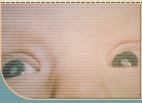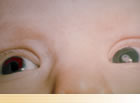
Welcome to the Infant Aphakia Treatment Study
The Infant Aphakia Treatment Study (IATS) is a clinical study designed to determine which treatment for aphakia is better for infants between the ages of 4 weeks to 7 months who were born with a cataract in one eye. The treatments being studied are use of a contact lens (CL) after surgery or surgically placing a plastic lens (intraocular lens - IOL) in the baby's eye after removing the cataract.
114 babies were enrolled in the study between December 2004 and December 2008; 57 were in the CL treatment group and 57 were in the IOL treatment group. Vision in both eyes was tested at 1 year of age and again at 4 1/2 years of age. In 2010 the results of the vision testing at 1 year of age were published. There was no difference in the vision in the treated eyes when comparing CL to IOL treatment. However, in the first year there were more complications and additional intraocular surgeries in the IOL group, but these had been anticipated.
113 of the 114 children in the study were followed until they were 5 years old. The results of the entire study were published in the Journal of the American Medical Association (JAMA Ophthalmology) in June 2014 (see the "IATS Results Abstract" link in the Symposium section, the link for which is on the right side of this page). At 4 1/2 years of age, again there was no difference in the vision between the eyes treated with CL compared to IOL. About half of the treated eyes in both groups had vision better than 20/200, but the IOL group had more complications and required more eye surgeries. Most of these complications occurred in the first year after the initial surgery. About a third of the treated eyes in both groups developed glaucoma or were suspicious for glaucoma.
Based on these results, the investigators recommended that when operating on an infant younger than 7 months of age with a unilateral cataract, that the eye be left aphakic and focused with a contact lens. IOL implantation at the time of cataract surgery should be reserved for those infants where, in the opinion of the surgeon, the cost and handling of a contact lens would be so difficult for the parents as to result in significant periods of uncorrected aphakia and the subsequent high risk of amblyopia.
This clinical study has been closely monitored by the National Institutes of Health, Food and Drug Administration, and a board of specialists that ensured that the study was conducted safely. Surgeons and study team members are experts in caring for children with cataracts.
